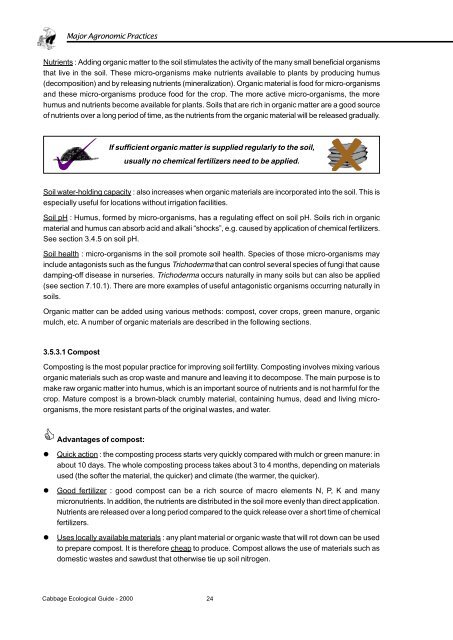Cabbage Integrated Pest Management : An Ecological Guide.
Cabbage Integrated Pest Management : An Ecological Guide.
Cabbage Integrated Pest Management : An Ecological Guide.
You also want an ePaper? Increase the reach of your titles
YUMPU automatically turns print PDFs into web optimized ePapers that Google loves.
Major Agronomic PracticesNutrients : Adding organic matter to the soil stimulates the activity of the many small beneficial organismsthat live in the soil. These micro-organisms make nutrients available to plants by producing humus(decomposition) and by releasing nutrients (mineralization). Organic material is food for micro-organismsand these micro-organisms produce food for the crop. The more active micro-organisms, the morehumus and nutrients become available for plants. Soils that are rich in organic matter are a good sourceof nutrients over a long period of time, as the nutrients from the organic material will be released gradually.If sufficient organic matter is supplied regularly to the soil,usually no chemical fertilizers need to be applied.Soil water-holding capacity : also increases when organic materials are incorporated into the soil. This isespecially useful for locations without irrigation facilities.Soil pH : Humus, formed by micro-organisms, has a regulating effect on soil pH. Soils rich in organicmaterial and humus can absorb acid and alkali “shocks”, e.g. caused by application of chemical fertilizers.See section 3.4.5 on soil pH.Soil health : micro-organisms in the soil promote soil health. Species of those micro-organisms mayinclude antagonists such as the fungus Trichoderma that can control several species of fungi that causedamping-off disease in nurseries. Trichoderma occurs naturally in many soils but can also be applied(see section 7.10.1). There are more examples of useful antagonistic organisms occurring naturally insoils.Organic matter can be added using various methods: compost, cover crops, green manure, organicmulch, etc. A number of organic materials are described in the following sections.3.5.3.1 CompostComposting is the most popular practice for improving soil fertility. Composting involves mixing variousorganic materials such as crop waste and manure and leaving it to decompose. The main purpose is tomake raw organic matter into humus, which is an important source of nutrients and is not harmful for thecrop. Mature compost is a brown-black crumbly material, containing humus, dead and living microorganisms,the more resistant parts of the original wastes, and water.C Advantages of compost:l Quick action : the composting process starts very quickly compared with mulch or green manure: inabout 10 days. The whole composting process takes about 3 to 4 months, depending on materialsused (the softer the material, the quicker) and climate (the warmer, the quicker).llGood fertilizer : good compost can be a rich source of macro elements N, P, K and manymicronutrients. In addition, the nutrients are distributed in the soil more evenly than direct application.Nutrients are released over a long period compared to the quick release over a short time of chemicalfertilizers.Uses locally available materials : any plant material or organic waste that will rot down can be usedto prepare compost. It is therefore cheap to produce. Compost allows the use of materials such asdomestic wastes and sawdust that otherwise tie up soil nitrogen.<strong>Cabbage</strong> <strong>Ecological</strong> <strong>Guide</strong> - 200024




![Section 4 [ PDF file, 252 KB] - The Field Alliance](https://img.yumpu.com/51387260/1/158x260/section-4-pdf-file-252-kb-the-field-alliance.jpg?quality=85)











